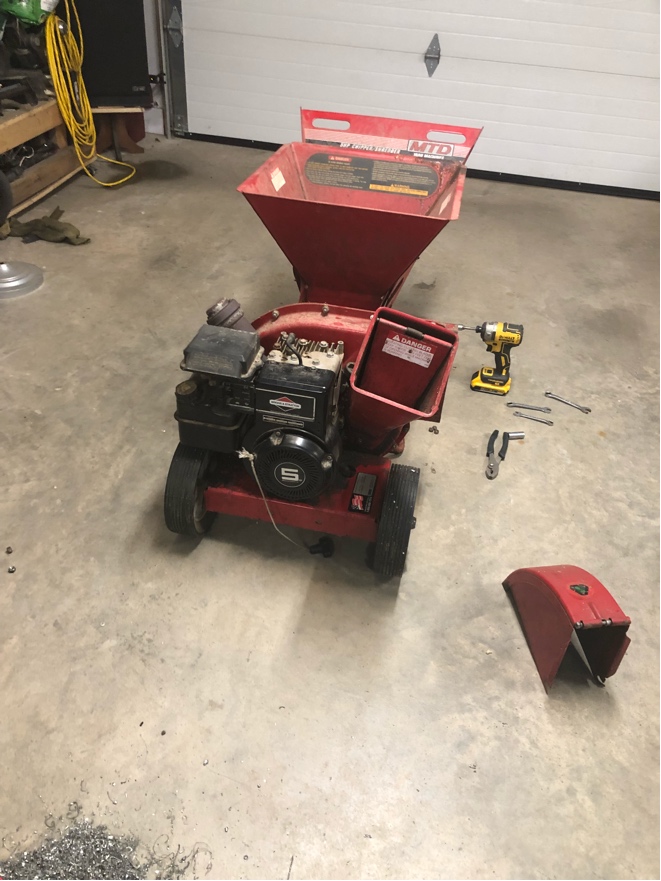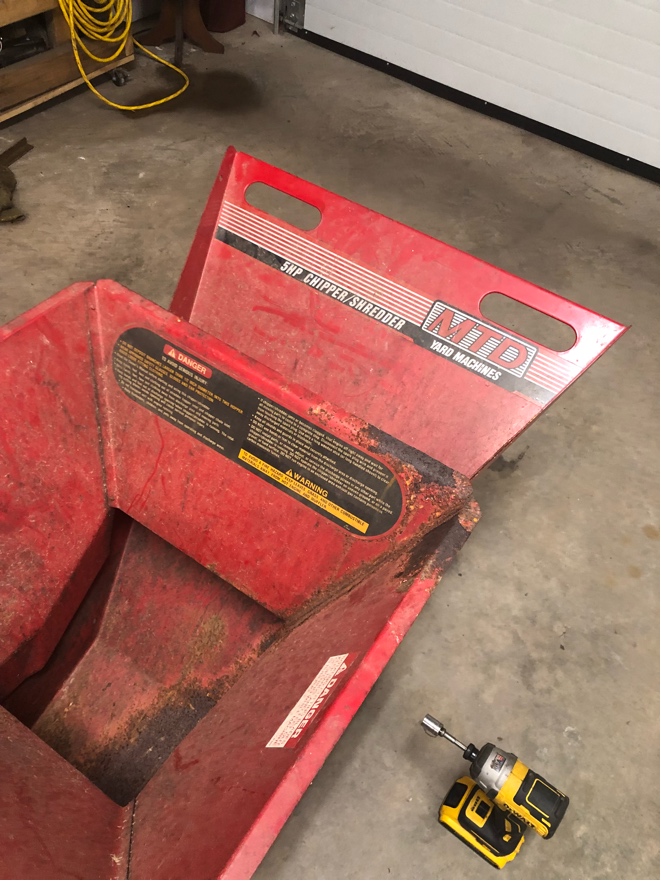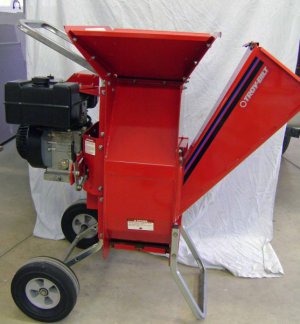- Joined
- Jan 25, 2015
- Messages
- 2,558
I've been needing a chipper shredder for a while now. Nothing big, just enough for twigs, smaller branches and leaves. But one never popped up locally at a price I wanted to pay. They were always beat up, overused, neglected and always waaaay than more they were worth.
The other day, an older MTD 5 hp one popped up. 275bucks. Price was in range. It's an older model, which means everything is steel. That's a plus to me. Only things plastic on it are the wheels, the air cleaner cover and the handle on the pull cord.
Ser number pegs it as a 1991 model.
I went to look at it. It ran half decent and was a bear to get running, but it was -10c out that day. The owner ran a couple branches through it and it at least worked.
So 250 bucks changed hands and it was on it's way home with me:


It's a typical piece in the usual condition for used small equipment for the east coast. Used, not well taken care of and just expected to work until it dies. Not much maintenance, not much care. Just hold out as long as it can and then throw it away once dead.
But this old soldier has weathered the abuse well and is still in decent shape, despite obviously minimal care. Well, those days are over my old friend; I take good care of my stuff and this will be no different. Welcome to a new life.
I fire it up at home and run a branch through it to get a baseline for how it does (or doesn't) work. It starts easily after a few hours sitting in a heated garage.
Well, it at least shredded the stick. But it more beat it to death than chipped it. I had to push a finagle it to keep it working on the stick end. And it’s really noisy with a metalic “clank” noise as it spins up or stops. I really didnt like that noise.
I shut it down and haul it into the garage to check the chipper blades and discover I'm being generous calling then "blades". They are more like round edged bludgeoning blocks of steel. Well, they need sharpening, no real surprise there. Par for the course in an old used peice of yard equipment.
You can remove just the blades, but I decided to just split the chipper housing and check everything out for good measure. That metallic “klank” noise fresh in my memory.
The disc is frozen to the engine shaft, so I just decided to leave it be. A puller wouldn't budge it and i didn't want to be pounding on what is actually the engine crankshaft.
There's a smaller lawn mower type blade on the back of the disc to mulch leaves and twigs and that is also dull as the day is long. You can tell as the chipper blades dulled and became less and less effective, people had started to jam larger and larger sticks into the mulching section to chop them up. Result: the light duty blade gets beat to crap.
There's also 12 metal flails that do the final stage of mulching/shredding on the disc. They’re in groups of 3 and fling outward when running. Some are frozen in place (rust) and are discovered to be the source of that metallic “klank” noise I was hearing.You can tell they've never been touched in the way of sharpening or maintenance. The profile is damned near worn away on the leading edges and every one of them in generally rounded over. Luckily, they are mirror images front and back, so all I had to do was pull them off, clean them up, lubricate and re-assemble with them flipped around and it's a factory fresh edge again.
Tomorrow I'll sharpen and balance the blades, straighten up a few of the metal bits and put it back together. While doing that, I'll clean it up and put a few other minor bits back to right as well.
So 250 bucks and a bit of labor and I've got myself (what looks to be) a decent chipper shredder. For it's intended uses at least. It's never going to chip up 4-6 inch branches, but it will work fine for my yard clean up purposes.
If I had rented one, that would have been around 50 bucks a day, so if it lasts more than a week (will for sure), I’m money ahead.
Not too shabby.
Next winter, I'll probably pull it apart again and give it a nice fresh coat of paint.

The other day, an older MTD 5 hp one popped up. 275bucks. Price was in range. It's an older model, which means everything is steel. That's a plus to me. Only things plastic on it are the wheels, the air cleaner cover and the handle on the pull cord.
Ser number pegs it as a 1991 model.
I went to look at it. It ran half decent and was a bear to get running, but it was -10c out that day. The owner ran a couple branches through it and it at least worked.
So 250 bucks changed hands and it was on it's way home with me:


It's a typical piece in the usual condition for used small equipment for the east coast. Used, not well taken care of and just expected to work until it dies. Not much maintenance, not much care. Just hold out as long as it can and then throw it away once dead.
But this old soldier has weathered the abuse well and is still in decent shape, despite obviously minimal care. Well, those days are over my old friend; I take good care of my stuff and this will be no different. Welcome to a new life.
I fire it up at home and run a branch through it to get a baseline for how it does (or doesn't) work. It starts easily after a few hours sitting in a heated garage.
Well, it at least shredded the stick. But it more beat it to death than chipped it. I had to push a finagle it to keep it working on the stick end. And it’s really noisy with a metalic “clank” noise as it spins up or stops. I really didnt like that noise.
I shut it down and haul it into the garage to check the chipper blades and discover I'm being generous calling then "blades". They are more like round edged bludgeoning blocks of steel. Well, they need sharpening, no real surprise there. Par for the course in an old used peice of yard equipment.
You can remove just the blades, but I decided to just split the chipper housing and check everything out for good measure. That metallic “klank” noise fresh in my memory.
The disc is frozen to the engine shaft, so I just decided to leave it be. A puller wouldn't budge it and i didn't want to be pounding on what is actually the engine crankshaft.
There's a smaller lawn mower type blade on the back of the disc to mulch leaves and twigs and that is also dull as the day is long. You can tell as the chipper blades dulled and became less and less effective, people had started to jam larger and larger sticks into the mulching section to chop them up. Result: the light duty blade gets beat to crap.
There's also 12 metal flails that do the final stage of mulching/shredding on the disc. They’re in groups of 3 and fling outward when running. Some are frozen in place (rust) and are discovered to be the source of that metallic “klank” noise I was hearing.You can tell they've never been touched in the way of sharpening or maintenance. The profile is damned near worn away on the leading edges and every one of them in generally rounded over. Luckily, they are mirror images front and back, so all I had to do was pull them off, clean them up, lubricate and re-assemble with them flipped around and it's a factory fresh edge again.
Tomorrow I'll sharpen and balance the blades, straighten up a few of the metal bits and put it back together. While doing that, I'll clean it up and put a few other minor bits back to right as well.
So 250 bucks and a bit of labor and I've got myself (what looks to be) a decent chipper shredder. For it's intended uses at least. It's never going to chip up 4-6 inch branches, but it will work fine for my yard clean up purposes.
If I had rented one, that would have been around 50 bucks a day, so if it lasts more than a week (will for sure), I’m money ahead.
Not too shabby.
Next winter, I'll probably pull it apart again and give it a nice fresh coat of paint.
Last edited:


